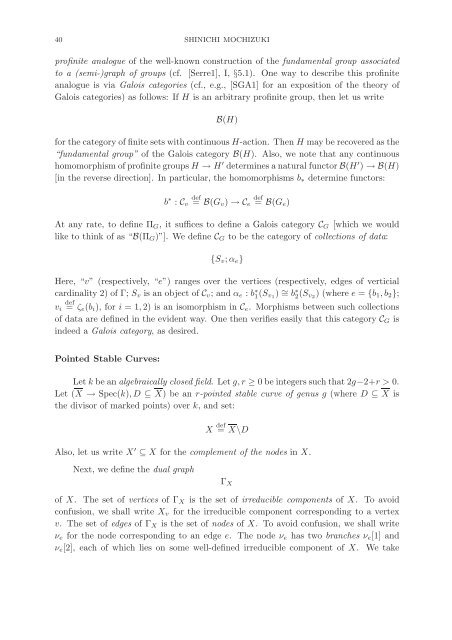The Absolute Anabelian Geometry of Hyperbolic Curves
The Absolute Anabelian Geometry of Hyperbolic Curves
The Absolute Anabelian Geometry of Hyperbolic Curves
Create successful ePaper yourself
Turn your PDF publications into a flip-book with our unique Google optimized e-Paper software.
40 SHINICHI MOCHIZUKI<br />
pr<strong>of</strong>inite analogue <strong>of</strong> the well-known construction <strong>of</strong> the fundamental group associated<br />
to a (semi-)graph <strong>of</strong> groups (cf. [Serre1], I, §5.1). One way to describe this pr<strong>of</strong>inite<br />
analogue is via Galois categories (cf., e.g., [SGA1] for an exposition <strong>of</strong> the theory <strong>of</strong><br />
Galois categories) as follows: If H is an arbitrary pr<strong>of</strong>inite group, then let us write<br />
B(H)<br />
for the category <strong>of</strong> finite sets with continuous H-action. <strong>The</strong>n H may be recovered as the<br />
“fundamental group” <strong>of</strong> the Galois category B(H). Also, we note that any continuous<br />
homomorphism <strong>of</strong> pr<strong>of</strong>inite groups H → H ′ determines a natural functor B(H ′ ) →B(H)<br />
[in the reverse direction]. In particular, the homomorphisms b ∗ determine functors:<br />
b ∗ : C v<br />
def<br />
= B(G v ) →C e<br />
def<br />
= B(G e )<br />
At any rate, to define Π G , it suffices to define a Galois category C G [which we would<br />
like to think <strong>of</strong> as “B(Π G )”]. We define C G to be the category <strong>of</strong> collections <strong>of</strong> data:<br />
{S v ; α e }<br />
Here, “v” (respectively, “e”) ranges over the vertices (respectively, edges <strong>of</strong> verticial<br />
cardinality 2) <strong>of</strong> Γ; S v is an object <strong>of</strong> C v ;andα e : b ∗ 1 (S v 1<br />
) ∼ = b ∗ 2 (S v 2<br />
)(wheree = {b 1 ,b 2 };<br />
def<br />
v i = ζ e (b i ), for i =1, 2) is an isomorphism in C e . Morphisms between such collections<br />
<strong>of</strong> data are defined in the evident way. One then verifies easily that this category C G is<br />
indeed a Galois category, as desired.<br />
Pointed Stable <strong>Curves</strong>:<br />
Let k be an algebraically closed field. Letg, r ≥ 0 be integers such that 2g−2+r >0.<br />
Let (X → Spec(k),D ⊆ X) beanr-pointed stable curve <strong>of</strong> genus g (where D ⊆ X is<br />
the divisor <strong>of</strong> marked points) over k, and set:<br />
X def<br />
= X\D<br />
Also, let us write X ′ ⊆ X for the complement <strong>of</strong> the nodes in X.<br />
Next, we define the dual graph<br />
Γ X<br />
<strong>of</strong> X. <strong>The</strong> set <strong>of</strong> vertices <strong>of</strong> Γ X is the set <strong>of</strong> irreducible components <strong>of</strong> X. To avoid<br />
confusion, we shall write X v for the irreducible component corresponding to a vertex<br />
v. <strong>The</strong> set <strong>of</strong> edges <strong>of</strong> Γ X is the set <strong>of</strong> nodes <strong>of</strong> X. To avoid confusion, we shall write<br />
ν e for the node corresponding to an edge e. <strong>The</strong> node ν e has two branches ν e [1] and<br />
ν e [2], each <strong>of</strong> which lies on some well-defined irreducible component <strong>of</strong> X. We take
















